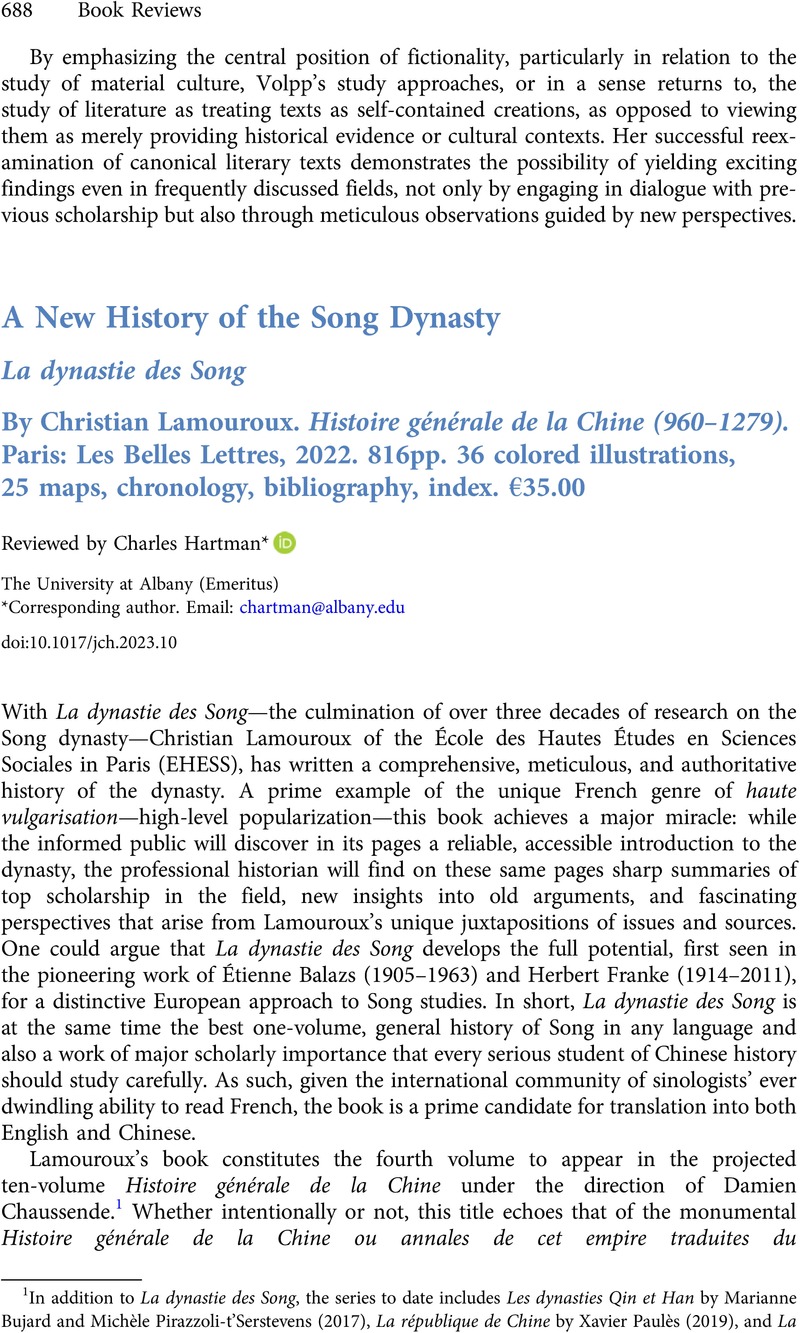No CrossRef data available.
Published online by Cambridge University Press: 04 September 2023

1 In addition to La dynastie des Song, the series to date includes Les dynasties Qin et Han by Marianne Bujard and Michèle Pirazzoli-t'Serstevens (2017), La république de Chine by Xavier Paulès (2019), and La république populaire de Chine by Gilles Guiheux (2018). I am grateful to Pierre-Étienne Will for his guidance on several points regarding the recent history of French sinology.
2 Pierre-Étienne Will, “French Sinology,” Journal of Chinese History (2022), 4n6, doi:10.1017/jch.2022.27.
3 Will, Pierre-Étienne, “Jacques Gernet (1921–2018),” T'oung Pao 106 (2020), 487CrossRefGoogle Scholar, 503.
4 Will, “Jacques Gernet (1921–2018),” 491–92.
5 For Balazs and his relations with Braudel, see Zurndorfer, Harriet T., “Not Bound to China: Étienne Balazs, Fernand Braudel and the Politics of the Study of Chinese History in Post-War France,” Past and Present 185 (2004), 189–221CrossRefGoogle Scholar.
6 Will, “Jacques Gernet (1921–2018),” 493–95, 498–503, citations on pp. 499–500, 501.
7 “Hence the need to proceed step by step, putting the facts in their historical context and trying to bring out the links between the different aspects of China's evolution: society, political systems, economy, relations of the Chinese world with the other cultures of East Asia and the other civilizations of Eurasia, technology, intellectual life, and so on.” Gernet, A History of Chinese Civilization. Second Edition (New York: Cambridge University Press, 1996), 1.
8 For a contemporaneous account, see Lynn Hunt, “French History in the Last Twenty Years: The Rise and Fall of the Annales Paradigm,” Journal of Contemporary History 21.2 (April 1986), 209–24. For a voice from inside the debate by the president of EHESS from 1977 through 1985 see François Furet, “Beyond the Annales,” The Journal of Modern History 55.3 (1983), 389–410.
9 “Bernard Lepetit,” French Wikipédia, https://fr.wikipedia.org/wiki/Bernard_Lepetit (accessed January 23, 2023).
10 Bernard Lepetit, “Propositions pour une pratique restreinte de l'interdisciplinarité,” in Bernard Lepetit, Carnet de croquis: Sur la connaissance historique (Paris: Albin Michel, 1999), 303–13, quotation at p. 311. See also Jean-Yves Grenier, “Bernard Lepetit (1948–1996),” Annales: histoire, sciences sociales 51.3 (1996), 519–23.
11 Alain Arrault, Shao Yong (1012–1077), poète et cosmologue (Paris: Institut des hautes études chinoises, 2002); Anne Cheng, Histoire de la pensée chinoise (Paris: Seuil, 1997); Stéphane Feuillas, Su Shi—Commémorations (Paris: Les Belles Lettres, 2010); Roger Darrobers, Zhu Xi: Mémoire scellé sur la situation de l'empire (Paris: Le Belles Lettres, 2013).
12 Li Tao 李燾, Xu zizhi tongjian changbian 續資治通鑑長編 (Beijing: Zhonghua shuju, 2004), 233.5655.
13 Hilde De Weerdt, Information, Territory, and Networks: The Crisis and Maintenance of Empire in Song China (Cambridge, MA: Harvard University Asia Center, 2015); Ruth Mostern, “Dividing the Realm in Order to Govern”: The Spatial Organization of the Song State (Cambridge, MA: Harvard University Asia Center, 2011).
14 Christian Lamouroux, Fiscalité, comptes publics et politiques financières dans le Chine de Song. Le chapitre 179 du Songshi (Paris: Collège de France. Institut des hautes études chinoises, 2003).
15 Joseph McDermott and Shiba Yoshinobu, “Economic Change in China, 960–1279” in The Cambridge History of China. Volume 5. Part Two: Sung China, 960–1279, edited by John C. Chaffee and Denis Twitchett (Cambridge: Cambridge University Press, 2015), 321–436.
16 Robert Hymes, “Sung Society and Social Change,” in The Cambridge History of China. Volume 5. Part Two: Sung China, 960–1279, edited by John C. Chaffee and Denis Twitchett (Cambridge: Cambridge University Press, 2015), 526–664.
17 Charles O. Hucket, A Dictionary of Official Titles in Imperial China (Stanford: Stanford University Press, 1985), 400 translates Sanbanyuan according to the function of the office as “Bureau of Lesser Military Assignments.”
18 Christian Lamouroux, “Rites, espaces et finance: La recomposition de la souveraineté dans le Chine du 11e siècle,” Annales: Histoire, Sciences Sociales 51.2 (1996), 275–305; Chang Wei-ling, Cong Tianshu shidai dao guwen yundong—Bei Song qianqi de zhengzhi guocheng 從天書時代到古文運動—北宋前期的政治過程 (Taipei: Guoli Taiwan daxue chuban zhongxin, 2021).
19 Albert Welter, Monks, Rulers, and Literati: The Political Ascendancy of Chan Buddhism (Oxford: Oxford University Press, 2006).
20 Huan K'uan-chung 黃寬重, Songdai de jiazu yu shehui 宋代的家族與社會 (Beijing: Guojia tushuguan chubanshe, 2009), 163–85.
21 Patricia Ebrey, Family and Property in Sung China: Yüan Ts'ai's Precepts for the Social Life (Princeton: Princeton University Press, 1984); Joseph McDermott, The Making of a New Rural Order in South China (Cambridge: Cambridge University Press, 2014).
22 James T.C. Liu, China Turning Inward: Intellectual-Political Changes in the Early Twelfth Century (Cambridge: Council on East Asian Studies, Harvard University, 1988). Yü Ying-shih 余英時, Zhu Xi de lishi shijie: Songdai shidafu zhengzhi wenhua de yanjiu 朱熹的歷史世界: 宋代士大夫政治文化的研究, 2 vols. (Taipei: Yunchen wenhua, 2003).
23 Rossabi, Morris, ed., China Among Equals: The Middle Kingdom and its Neighbors, 10th–14th Centuries (Berkeley: University of California Press, 1983)CrossRefGoogle Scholar.
24 Hartman, Charles, The Making of Song Dynasty History: Sources and Narratives (Cambridge: Cambridge University Press, 2020), 189–90CrossRefGoogle Scholar.
25 For possible precursors of the Yuan ortoγ see Endicott-West, Elizabeth, “Merchant Associations in Yüan China: The Ortoγ,” Asia Major, Third Series, 2.2 (1989), 129–33Google Scholar.
26 Kuhn, Dieter, The Age of Confucian Rule: The Song Transformation of China (Cambridge, MA: The Belknap Press of Harvard University Press, 2009)Google Scholar. Linda Walton, Middle Period China, 900–1350: A New History (Cambridge: Cambridge University Press, forthcoming).